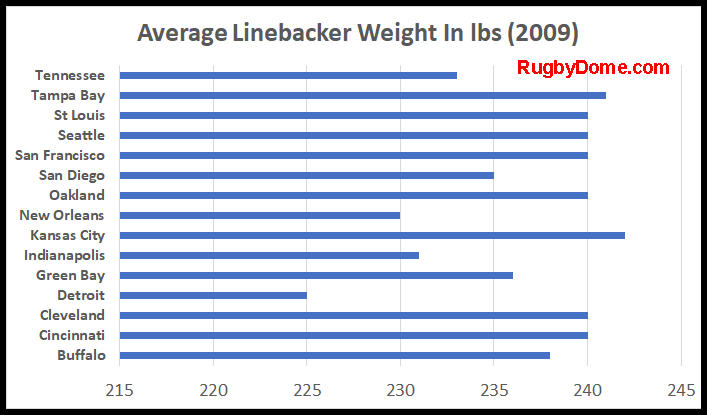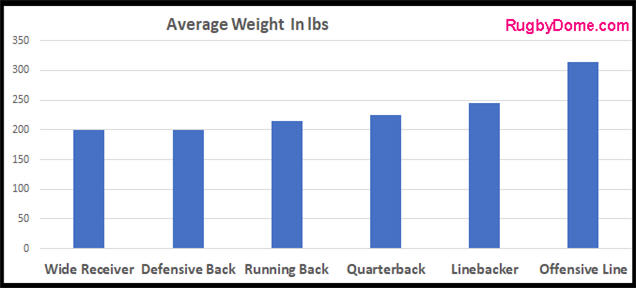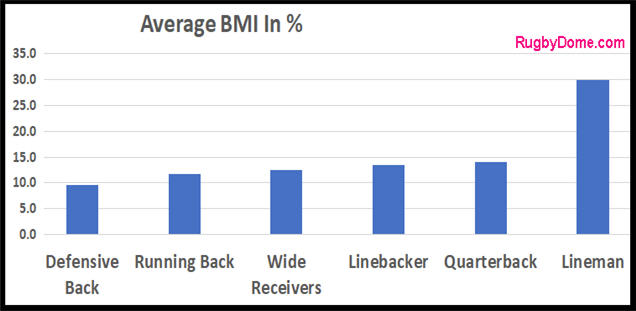The average weight of NFL linebackers is 245 lbs in recent years.
This is the second heaviest position in football. Linebackers tend to be about 70 lbs lighter than offensive linemen in the NFL.
College linebackers weigh an average of 233 lbs, which is about 74 lbs lighter than offensive linemen.
This article looks at how linebacker weights have fluctuated in the last two decades. We also compare the position to other sports.
NFL Linebacker Weights Since 2000
Linebackers actually got smaller in the first ten years of this century. They started off being pretty similar to what they are now. Then the pounds started to dwindle.
Weights from 2001 to 2010
Let’s take a look at the turn of the century.
We’ll start with the Pro Bowl roster in 2001. The average listed weight of the linebackers was 248 lbs.
The Pro Bowl is an annual all-star game with players selected by vote.
ESPN reported that the average linebacker weight at the Pro Bowl in 2007 had reduced to 240 lbs.
You may be thinking that the Pro Bowl may not be representative. So, let’s look at a study from the Bleacher Report in 2009 that examined weights across the NFL franchises.

Here is the raw data captured in the graph above:
| Team (2009) | Average Linebacker Weight |
| Buffalo | 238 lbs |
| Cincinnati | 240 lbs |
| Cleveland | 240 lbs |
| Detroit | 225 lbs |
| Green Bay | 236 lbs |
| Indianapolis | 231 lbs |
| Kansas City | 242 lbs |
| New Orleans | 230 lbs |
| Oakland | 240 lbs |
| San Diego | 235 lbs |
| San Francisco | 240 lbs |
| Seattle | 240 lbs |
| St Louis | 240 lbs |
| Tampa Bay | 241 lbs |
| Tennessee | 233 lbs |
This all averages out at 237 lbs in 2009.
Why did weights reduce?
The average linebacker weight reduced from 248 lbs in 2001 to 237 lbs in 2009.
A few commentators noted that this reduction was probably due to changes in the offensive line. Tight ends had slimmed down to be faster and more athletic.
The linebackers had to follow suit to be effective in covering them.
Weights from 2010 to now
Given that the current average is about 245 lbs, the weight clearly shifted in the other direction over the last ten years.
In other words, linebackers have gotten heavier.
Why have linebacker weights increased again?

If you read our separate article on average linemen weights, you’ll see that the numbers for the offensive line ballooned since the 2010s.
Linebackers have to be fast enough to catch up with them. This seems to be why their weights have risen accordingly.
However, there is chatter again that linebackers are going to have to trim down a bit for the current game.
This is particularly due to the RPO trend (run-pass option) in football. I won’t go into this in detail in this article. But suffice it to say that the offensive tactics make for both bigger tight ends and faster rushers.
Linebackers have to cope with both!
How Do Linebackers Compare To Other Football Positions?
As I mentioned in the introduction, linebackers are the second heaviest players in the sport. Interestingly, they are not a whole lot bigger than quarterbacks.
Here is a graph across the positions:

The table below has the raw data for average weights:
| NFL | lbs |
| Offensive Line | 314 |
| Linebacker | 245 |
| Quarterback | 225 |
| Running Back | 214 |
| Wide Receiver | 200 |
| Defensive Back | 200 |
If you want more details about the other positions, check out these in-depth articles:
- Average weights of running backs in NFL and college football
- Average weights of linemen in NFL and college football
- Average weights of quarterbacks in NFL and college football
- Average weights of wide receivers in NFL and college football
- Average weights of defensive backs in NFL and college football
How does this compare to college football?
College football players aren’t as heavy as professional NFL players, but they’re still very big.
The average weight of linebackers in college football is 223 lbs, which is about ten pounds lighter than in the NFL.
This means that college recruits who make it through the draft have to bulk up in their first season.
It’s interesting to compare this with the difference in weights between linemen in college and the NFL. There is a seventeen-pound difference in the step up from college into the pro game.
That’s a significant increase. Young linemen are under even more pressure to pile on the weight.
How do linebackers compare to the average American male?
The CDC says that American men average at about 196 lbs.
Linebackers are significantly heavier than the average joe. But that’s only part of the difference.
A study in 2013 measured body fat percentage at the NFL Combine. Linebackers had a figure of 13.5%.
The average American male ranges from 18 to 24%.
By the way, linebackers are about four percent lower than defensive linemen. But they are significantly below offensive linemen who clock in at a whopping 24.6%.
Here is how the positions stack up against each other:

How Do Linebackers Compare To Other Sports?
Soccer is another team sport played with a ball. So, how do the round ball players size up with linebackers?
A survey of weights at the soccer World Cup in 2018 showed that soccer players were averaging at around 170 lbs. That’s a massive difference, and clearly not a fair contest!
What about heavyweight boxers? A recent champion, Anthony Joshua, weighed in at 240 lbs. This is a lot closer to the 245 lbs linebacker average.
What about rugby?
Finally, I’ll run some comparisons against rugby. As a contact sport, it is often compared with American football.
The guys in the front row of a rugby scrum can be pretty big. But that position has little similarity to a linebacker.
We’ve got an article that compares whether NFL players are bigger than rugby players. It covers heights and weights at many different positions.
We think rugby flankers are the nearest equivalent position to linebackers.

Flankers in elite rugby competitions weigh in at an average of 236 pounds. That’s nine pounds heavier than the average for linebackers.
If you’re interested in more comparisons, check out our article that compares rugby and football players in terms of lifting weights..